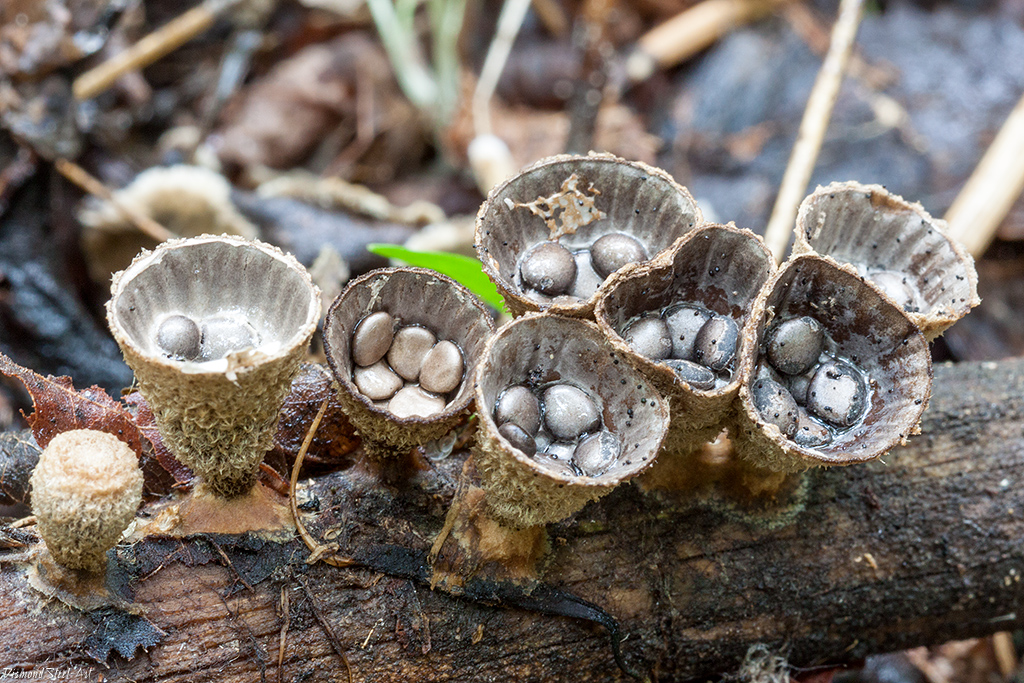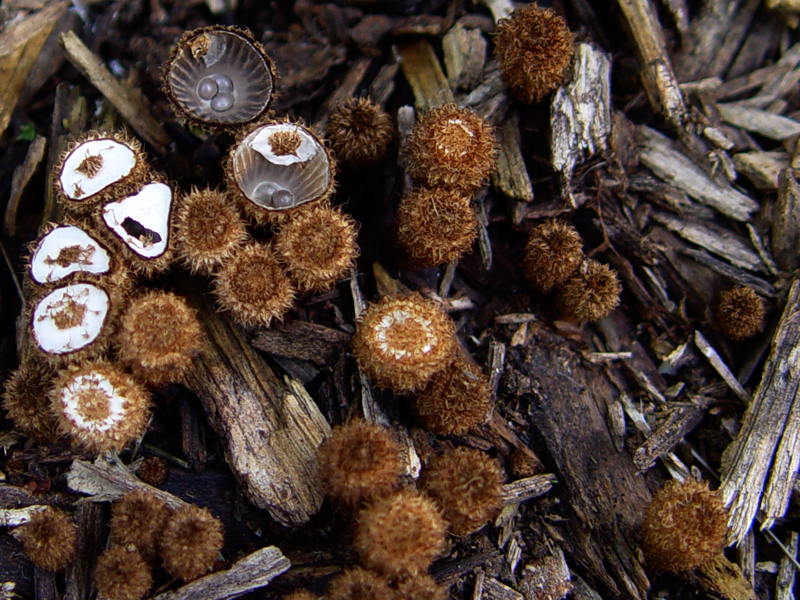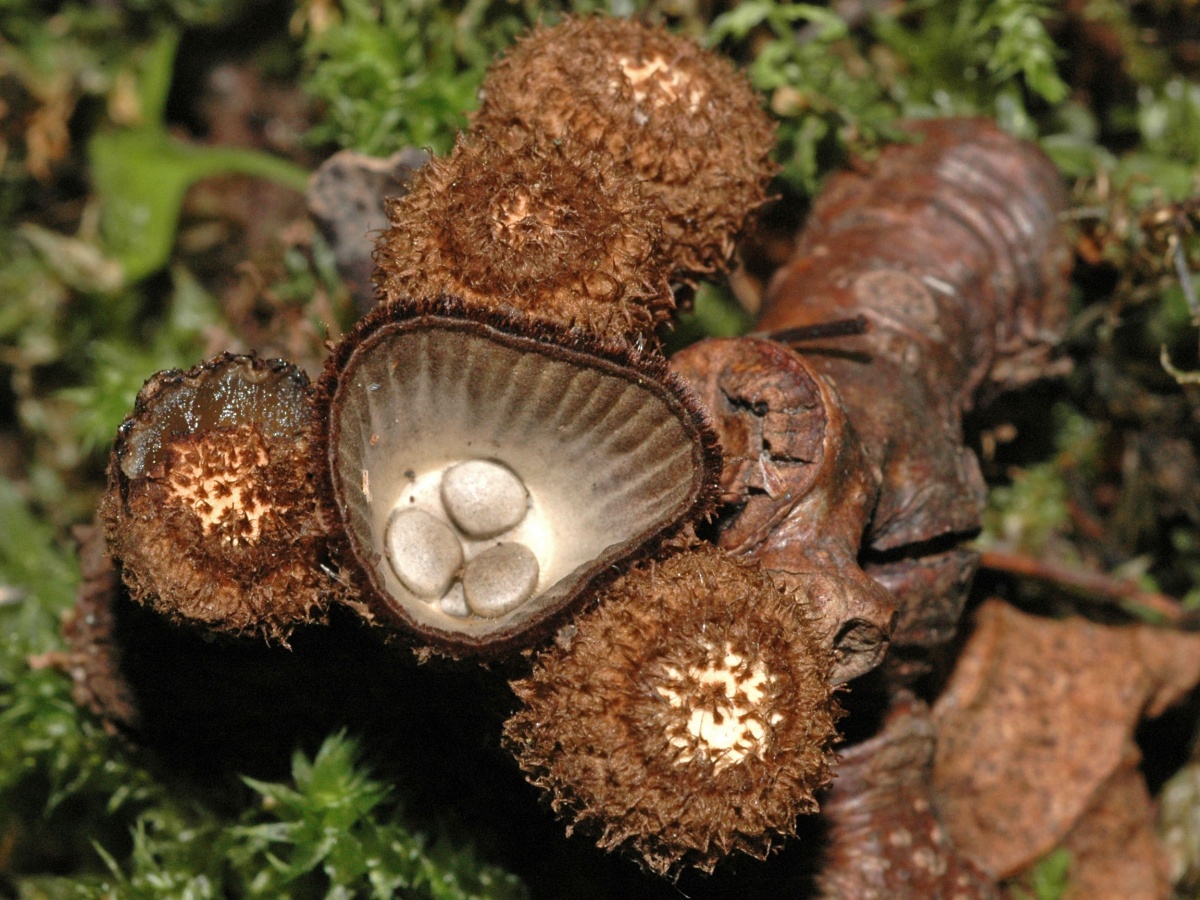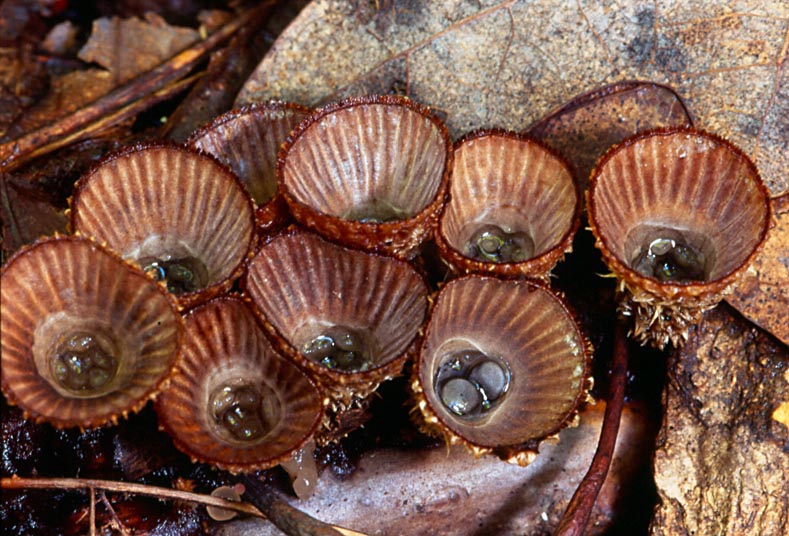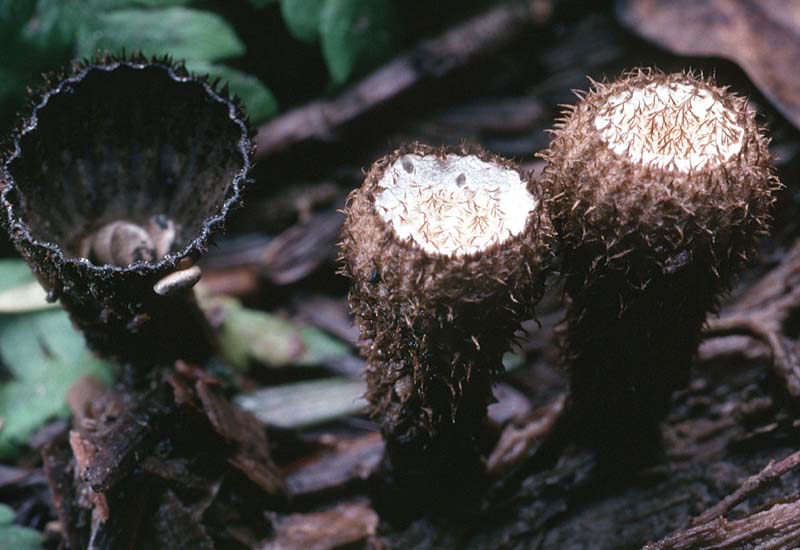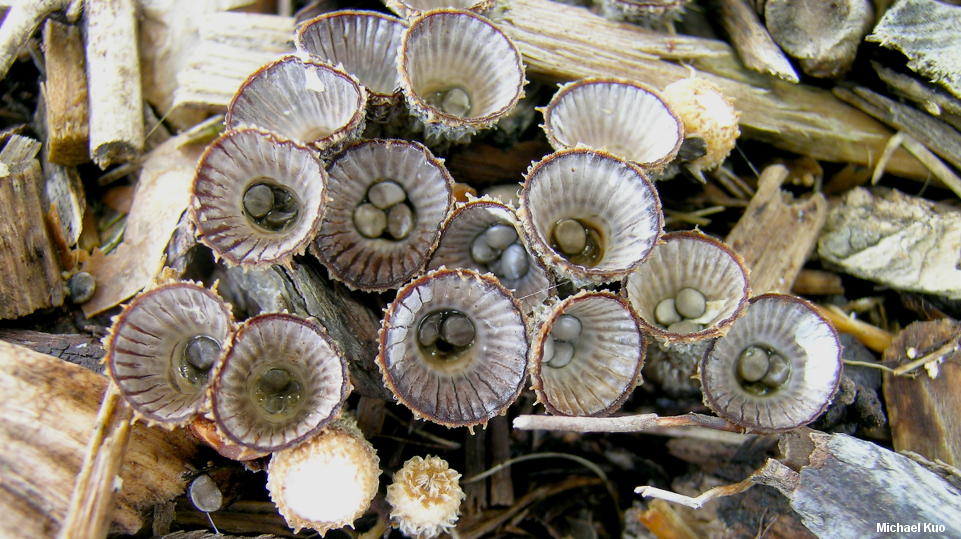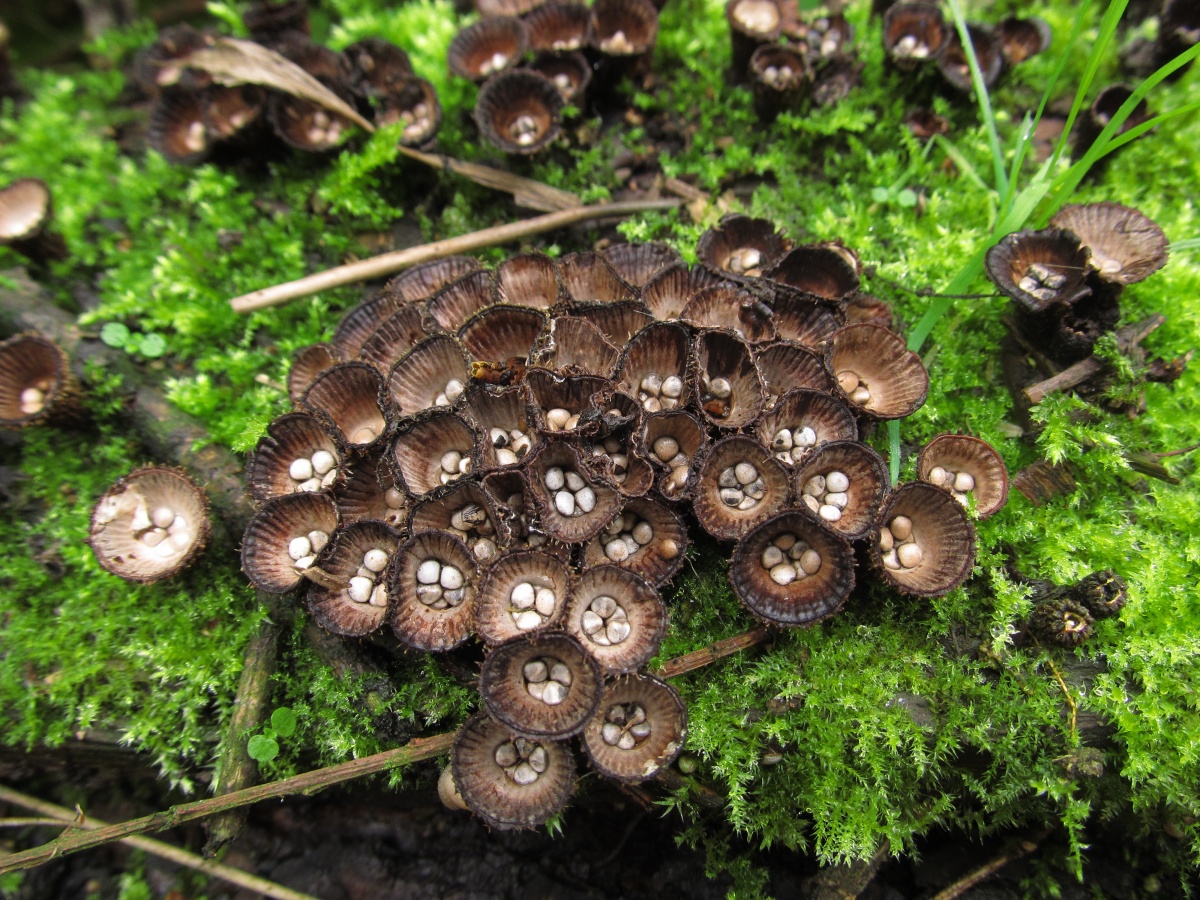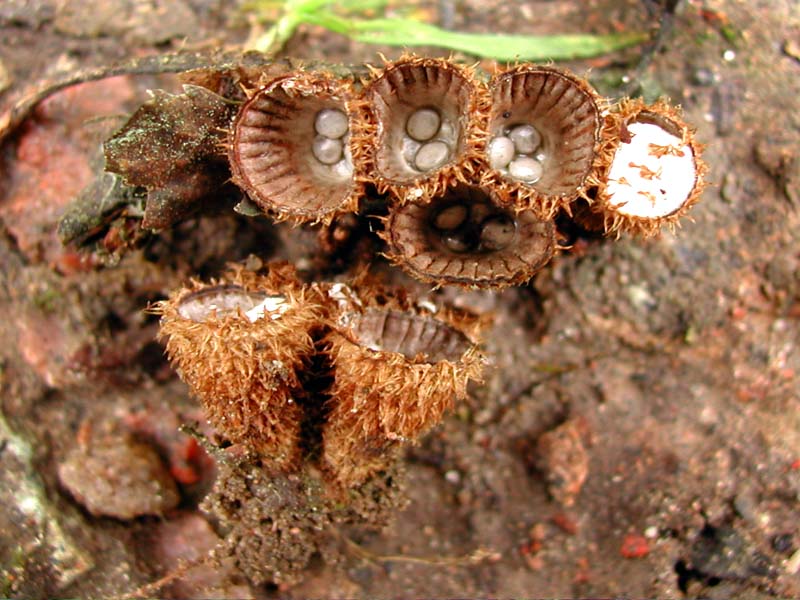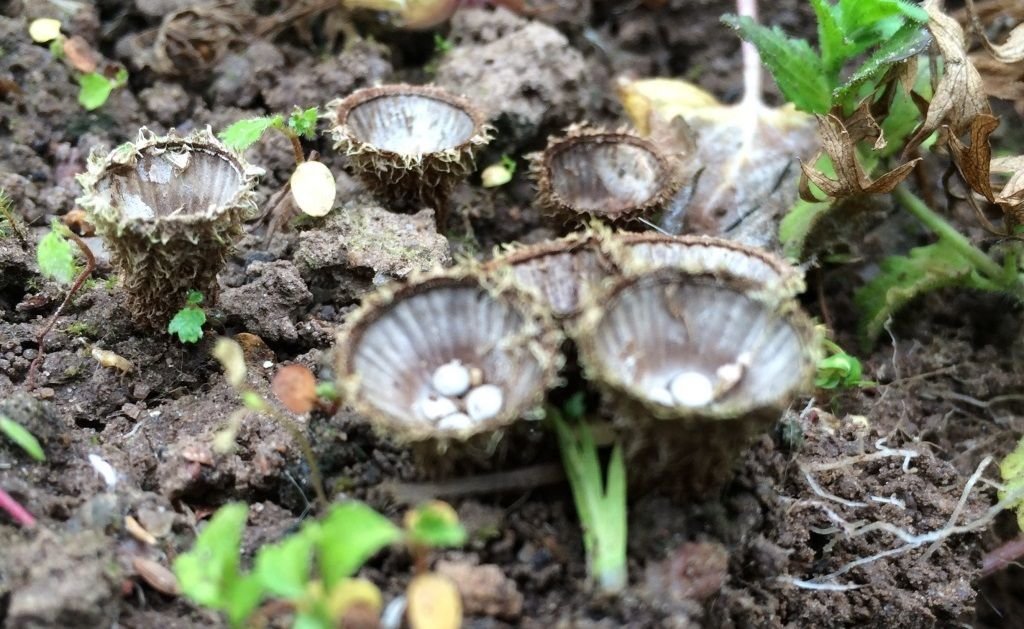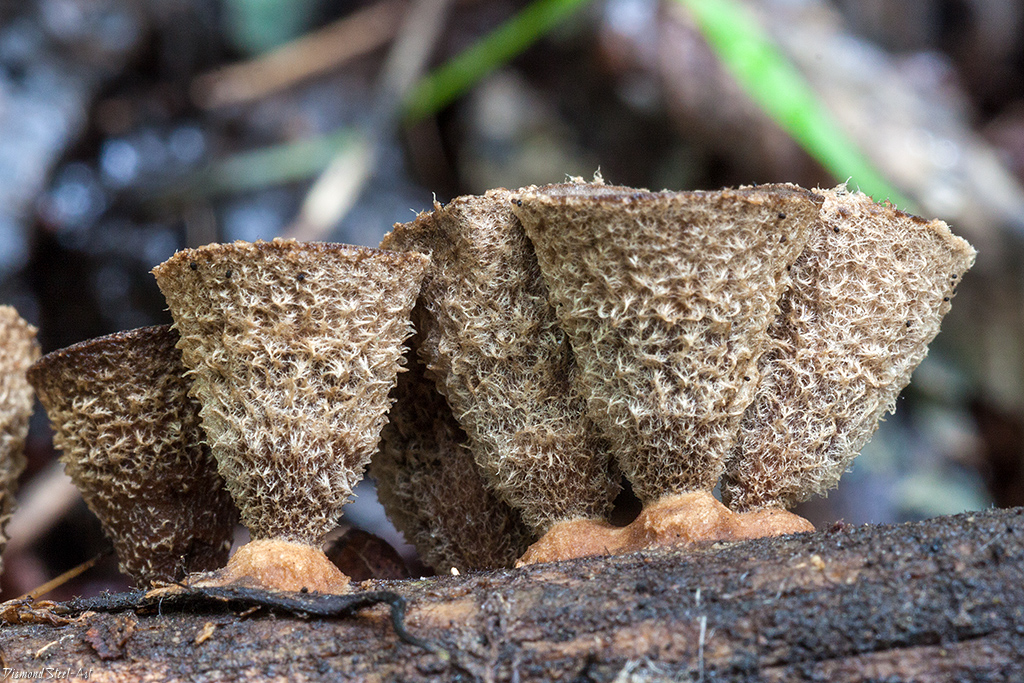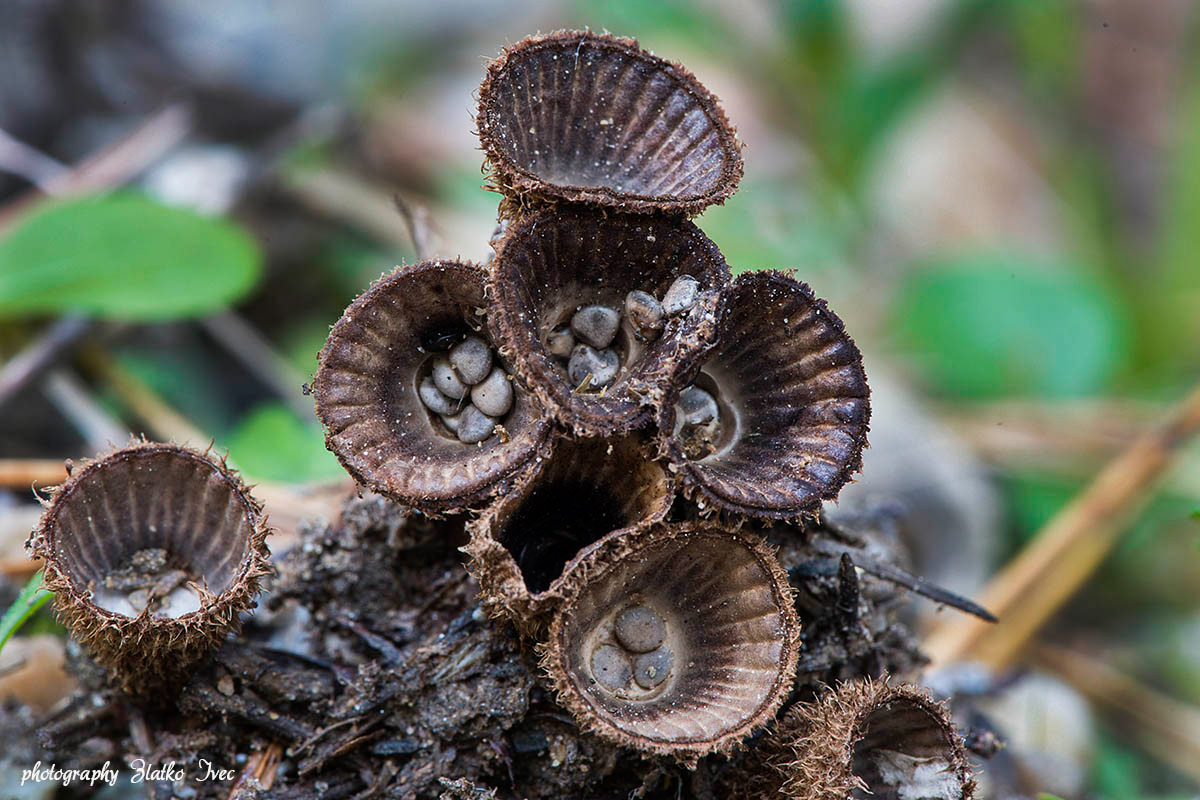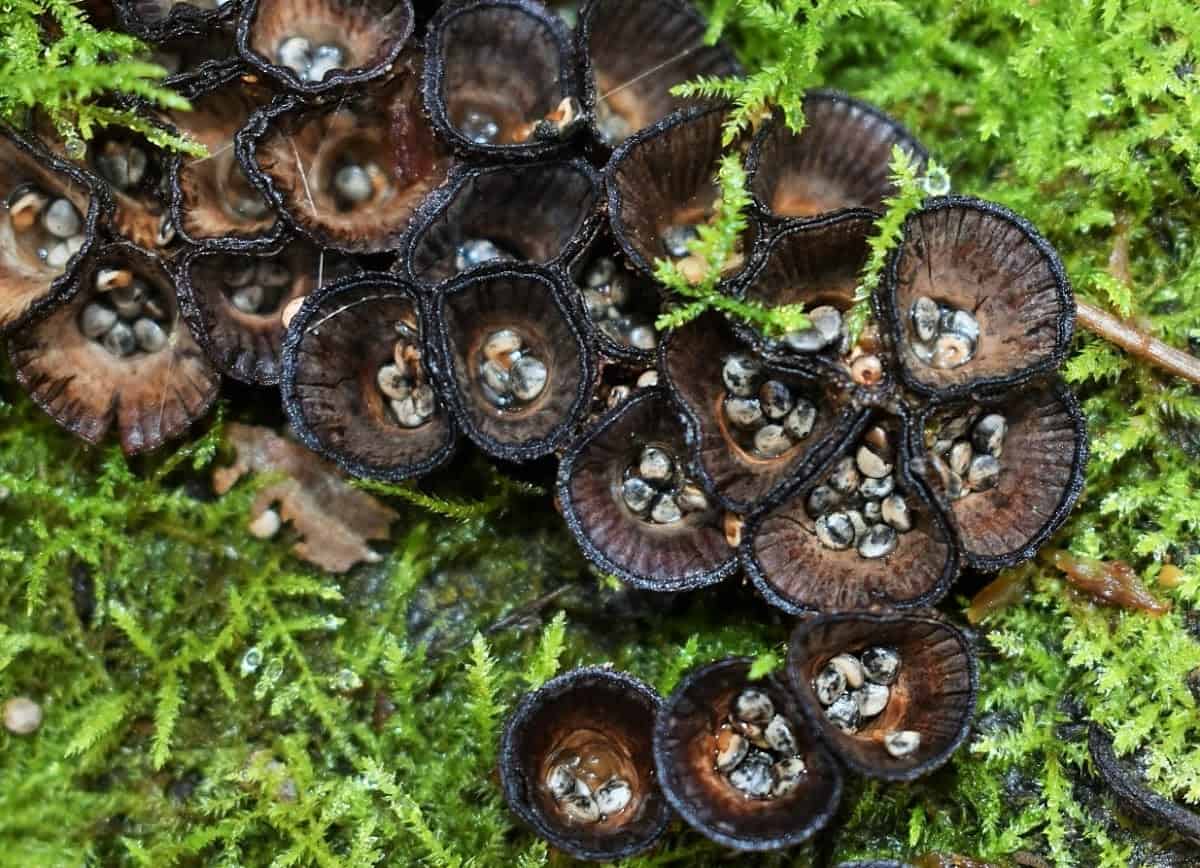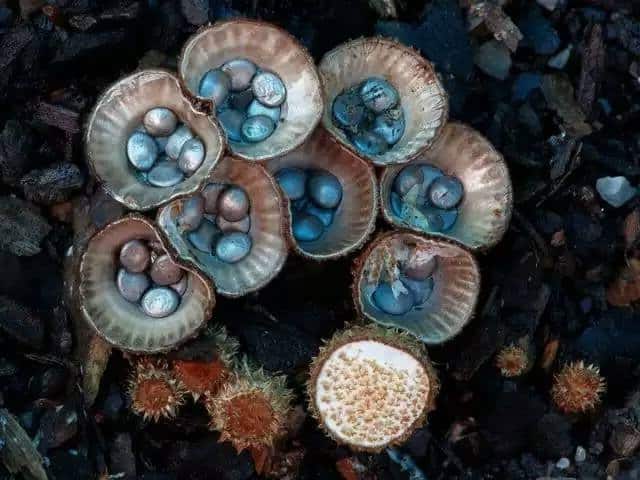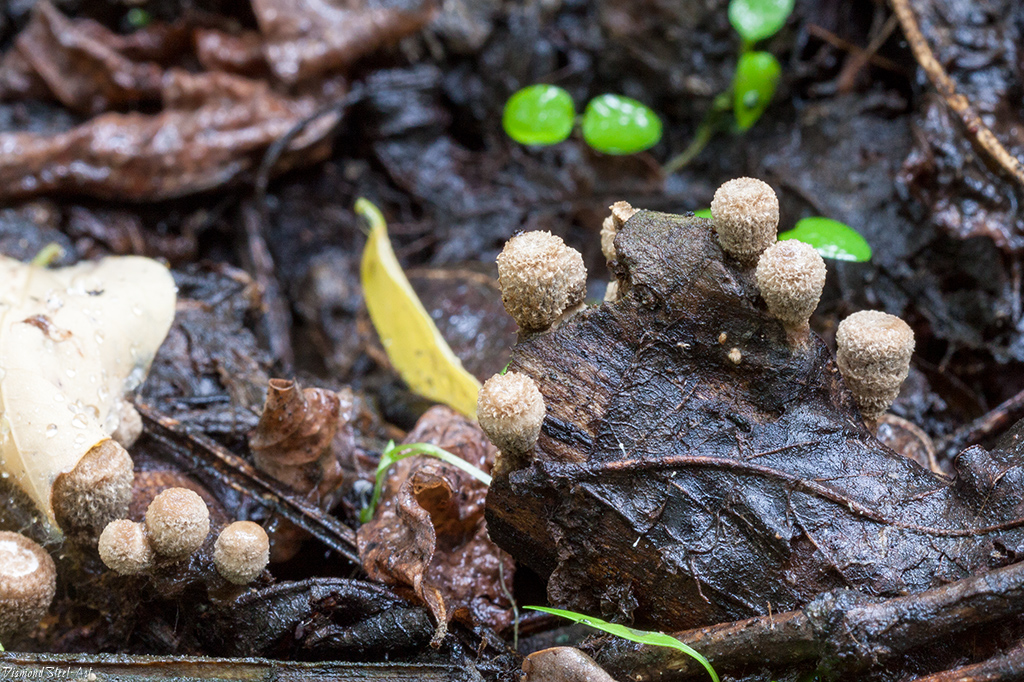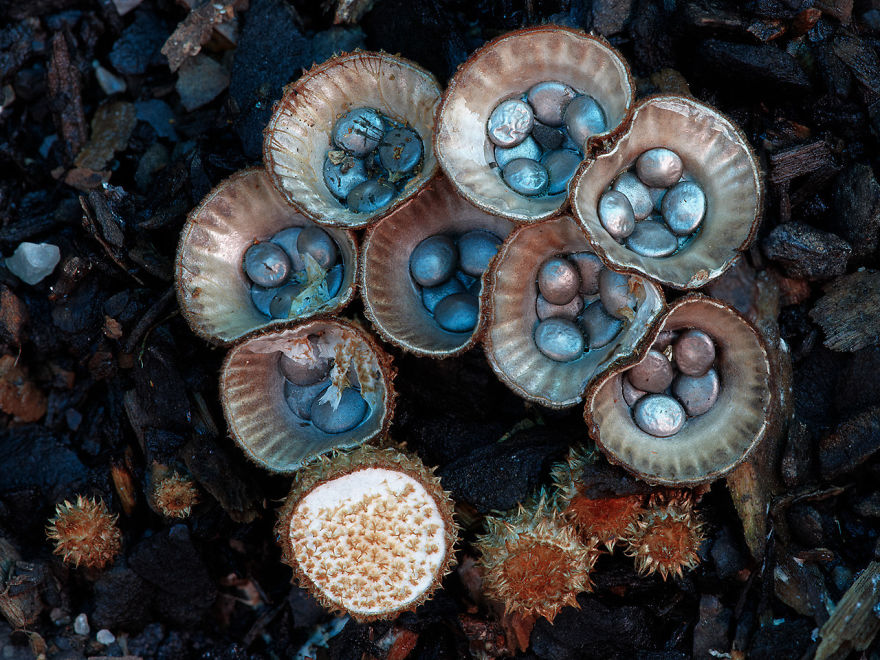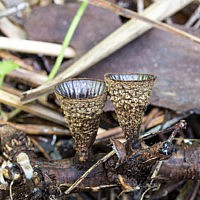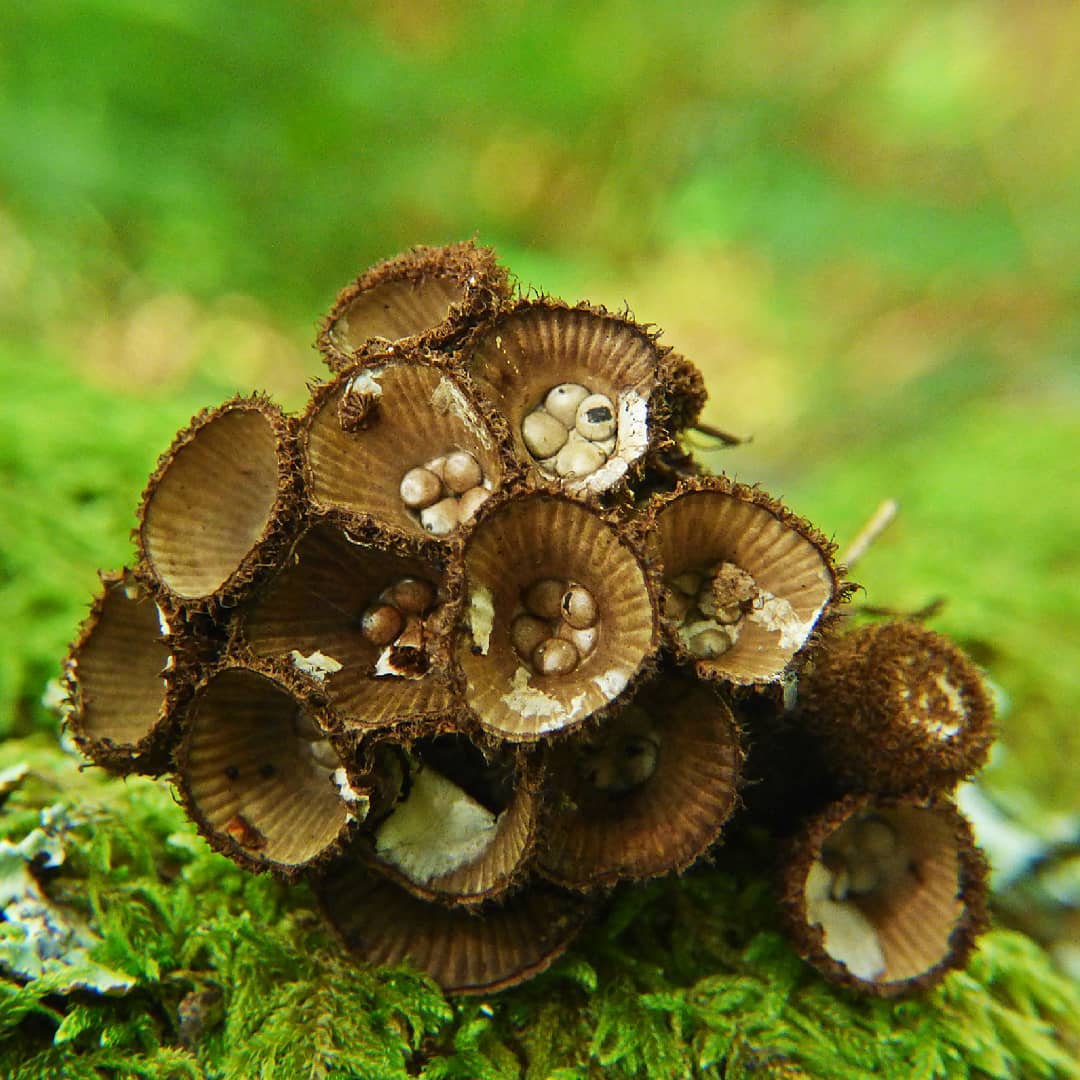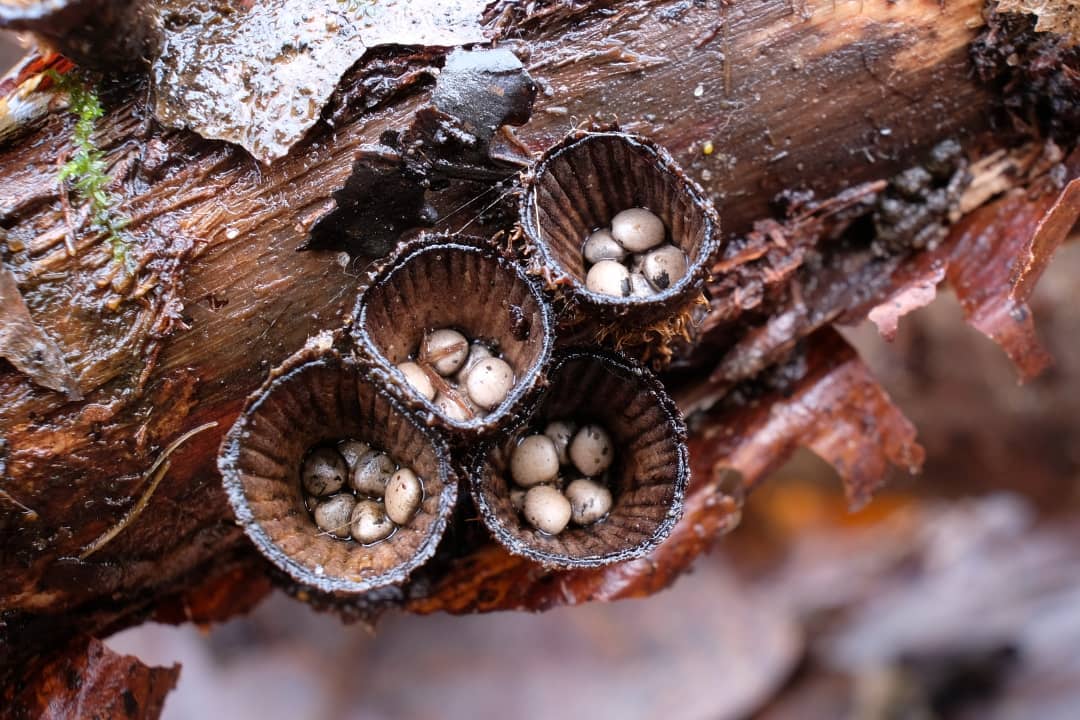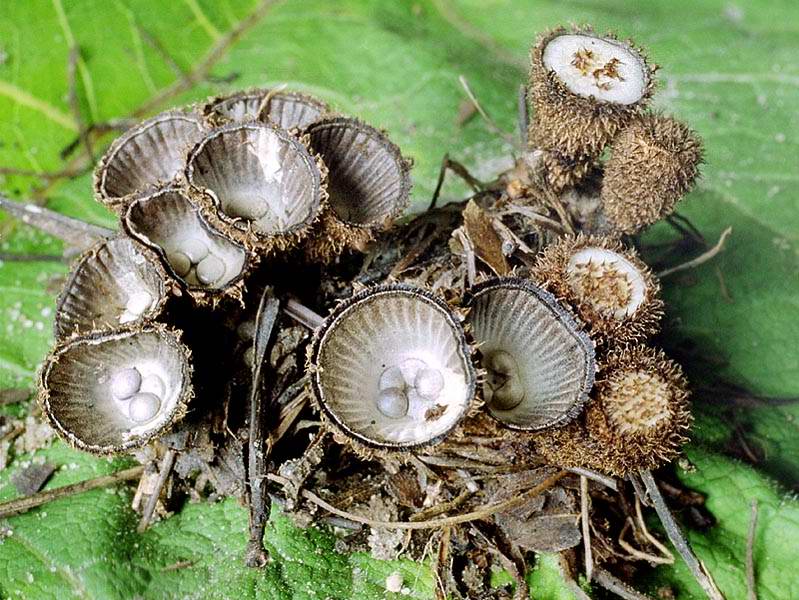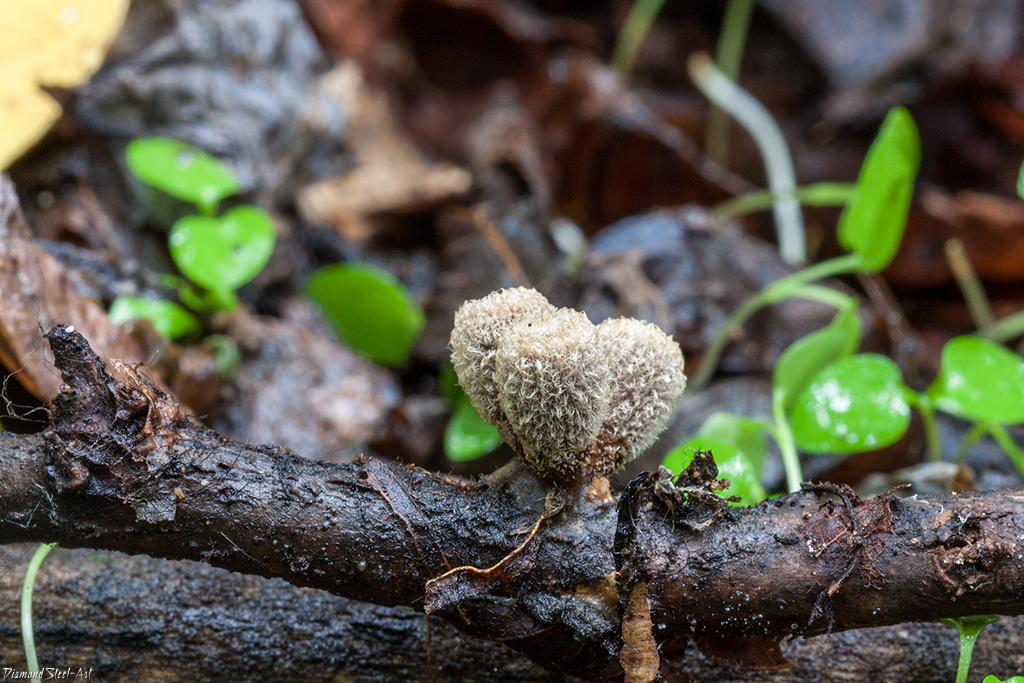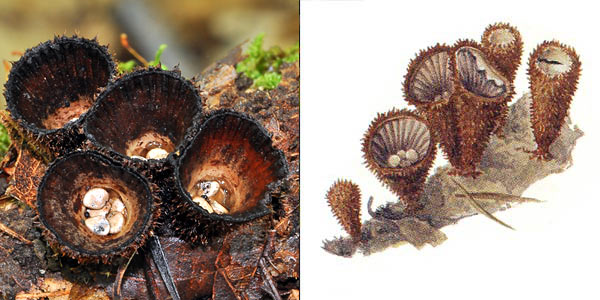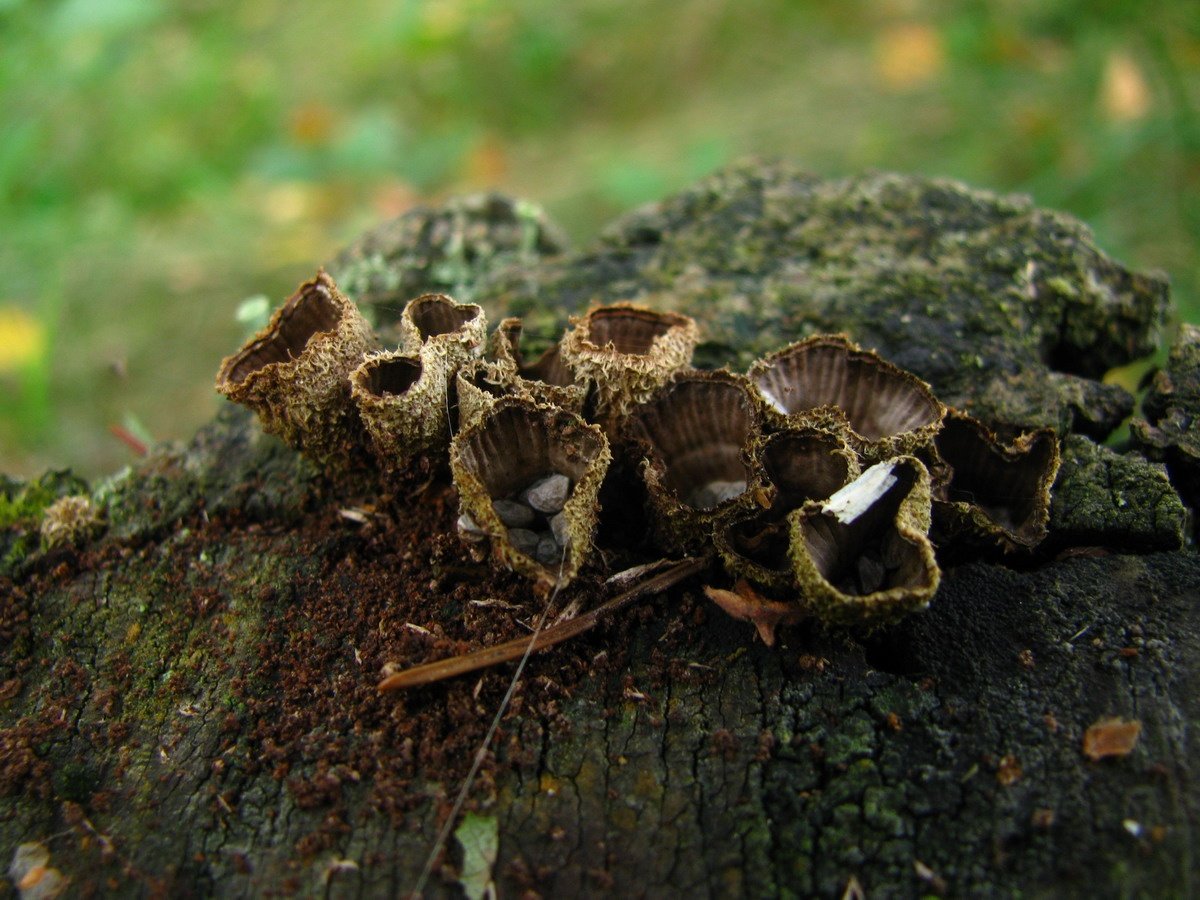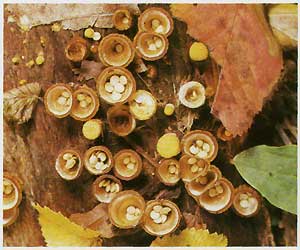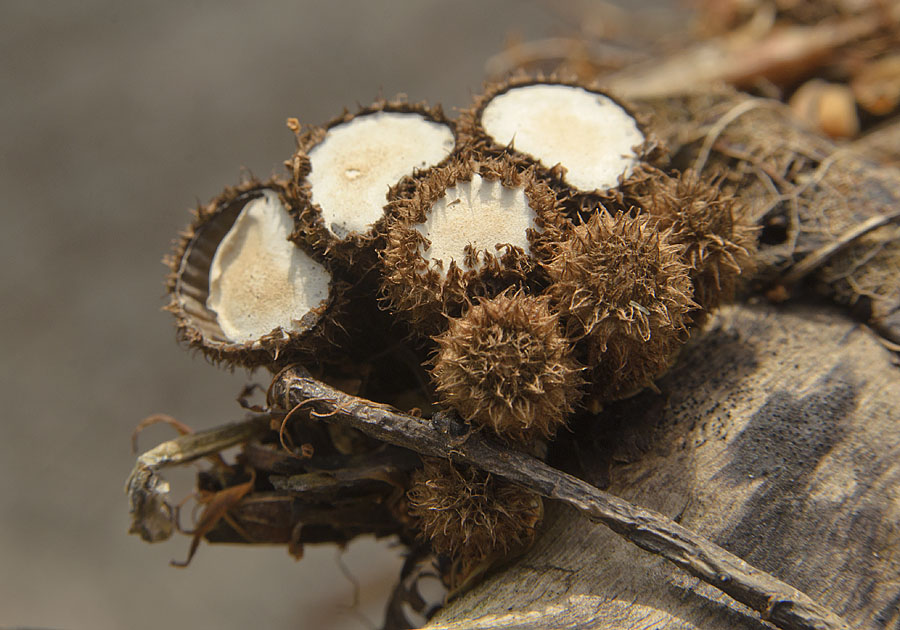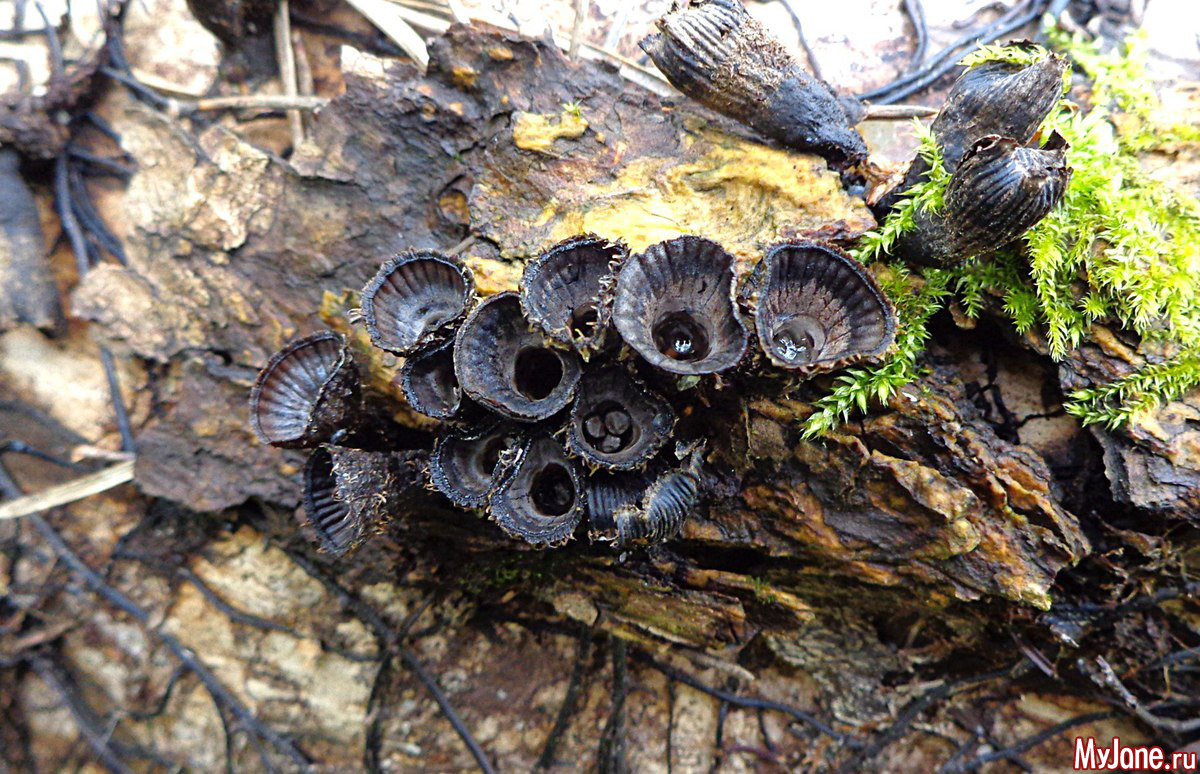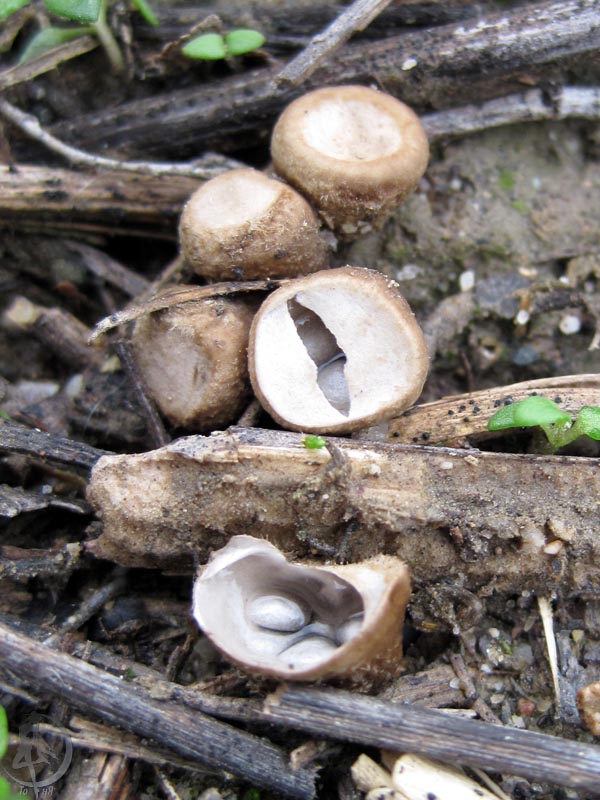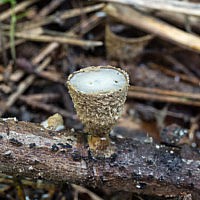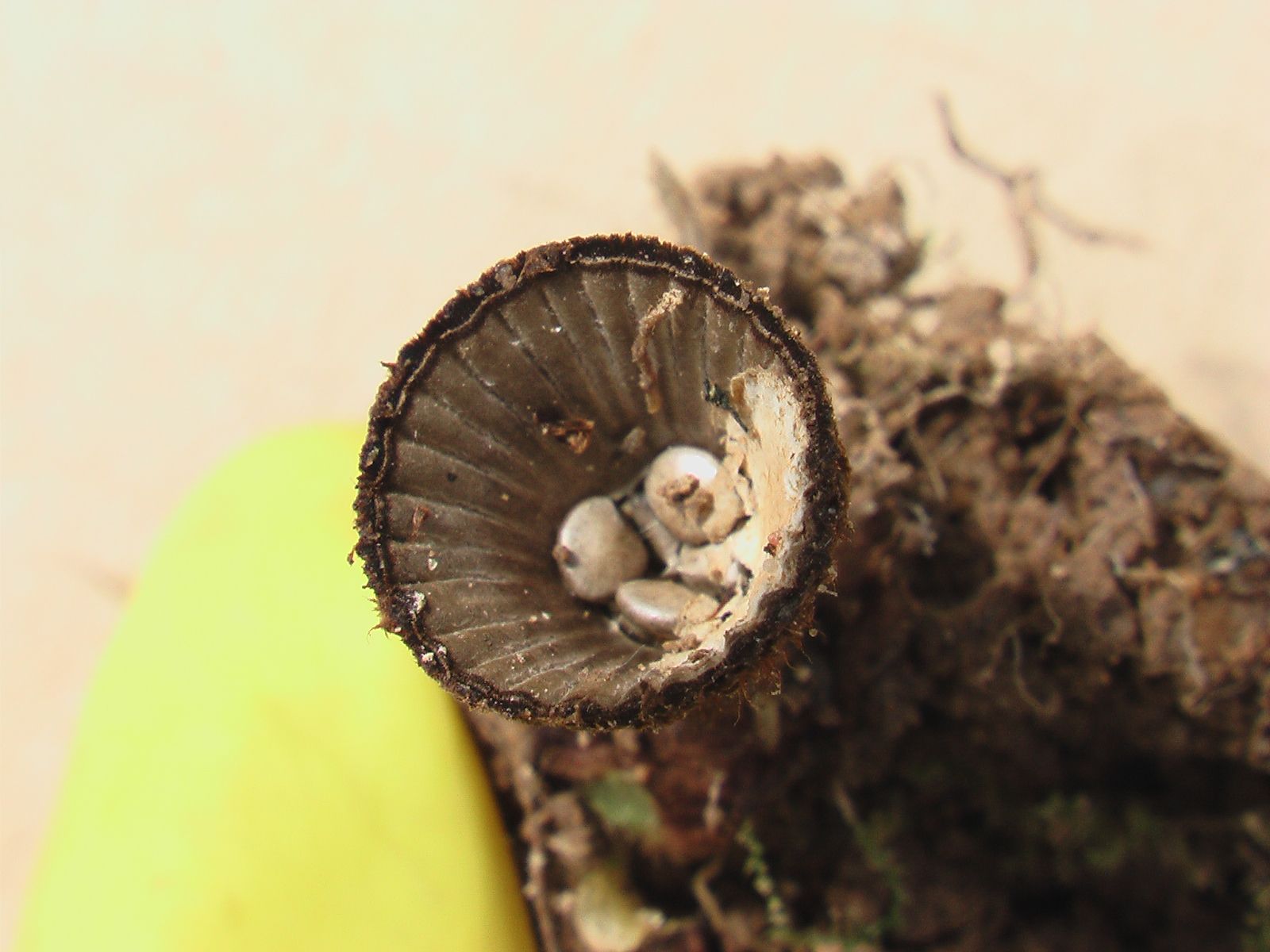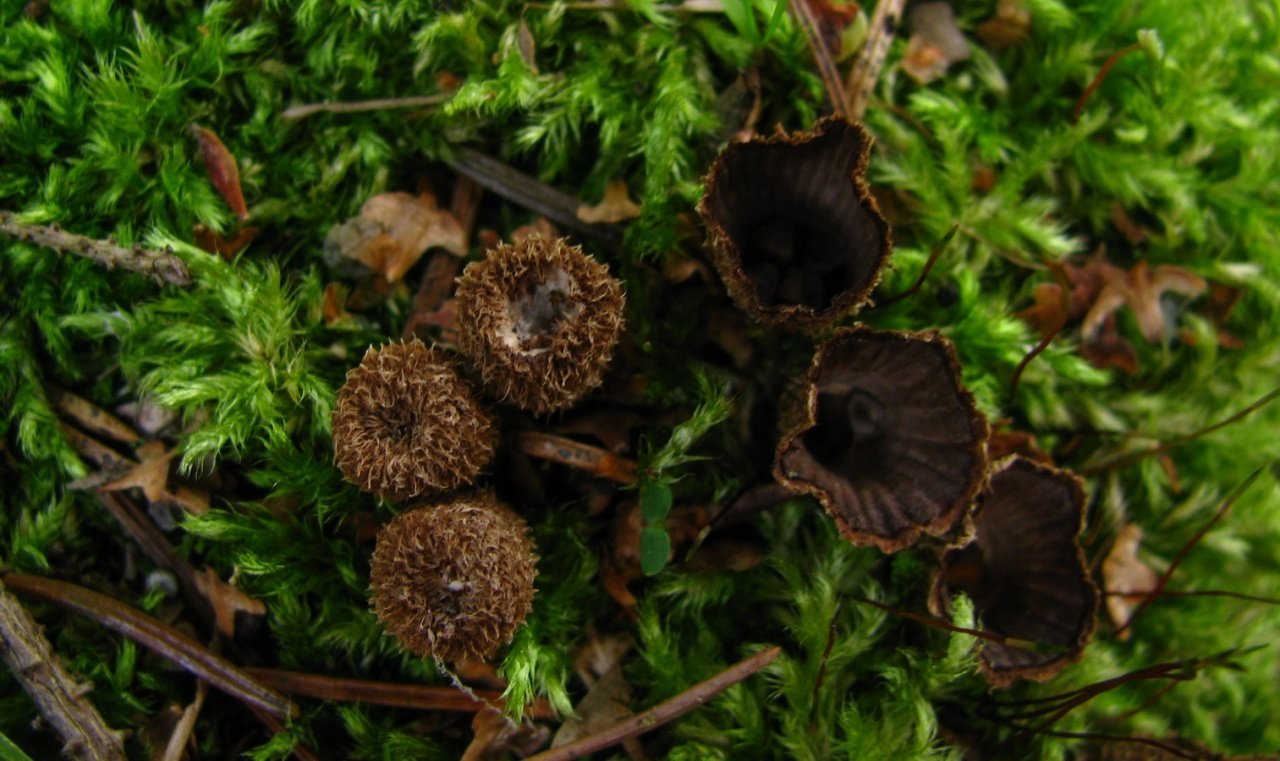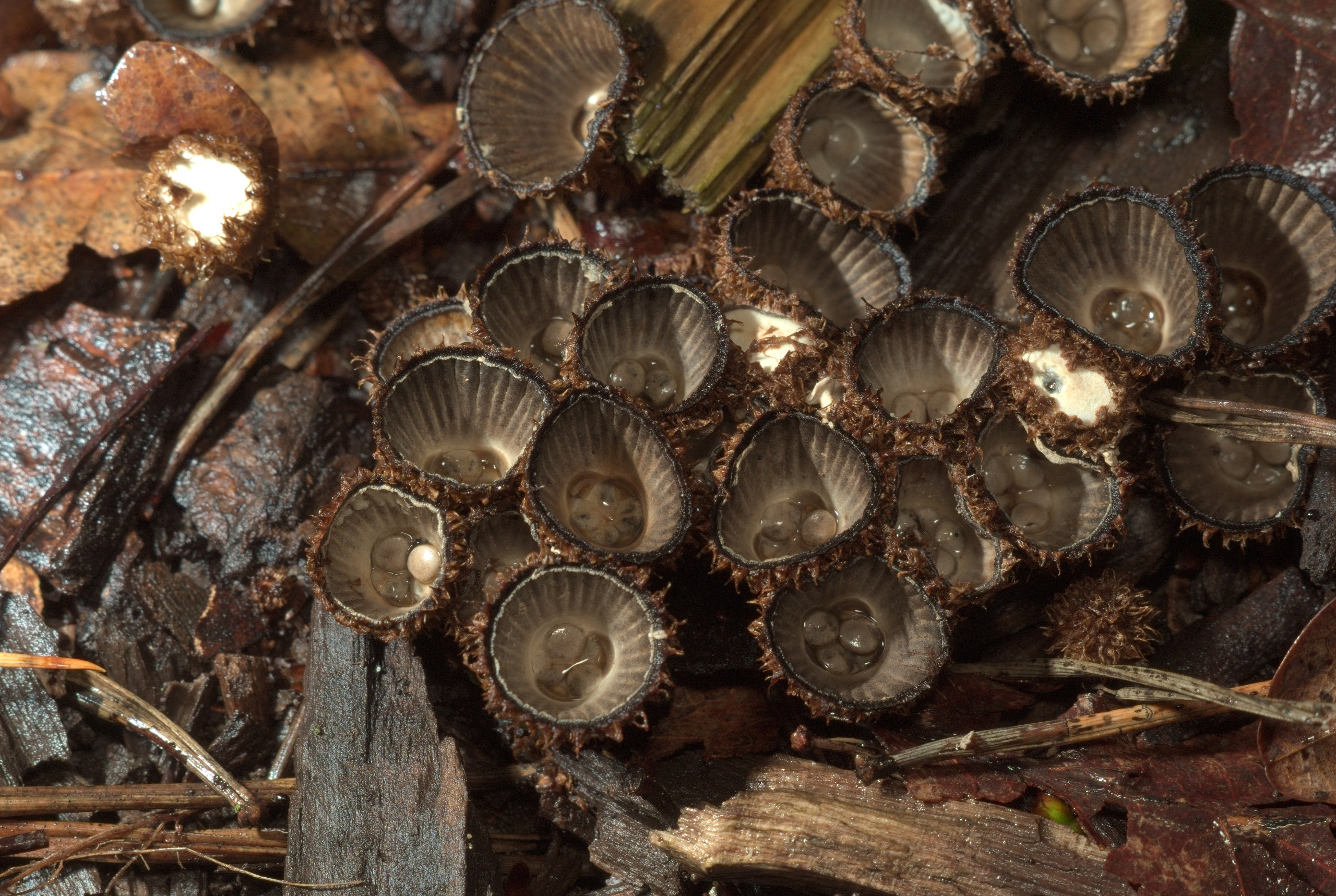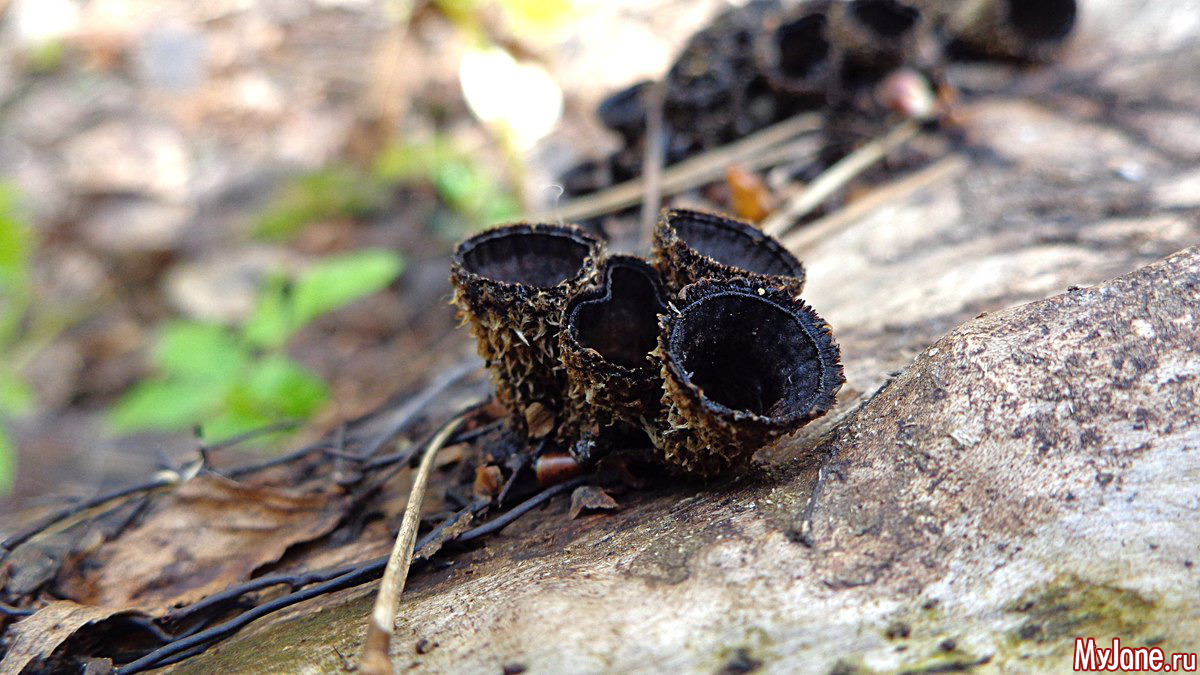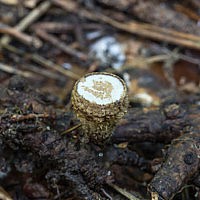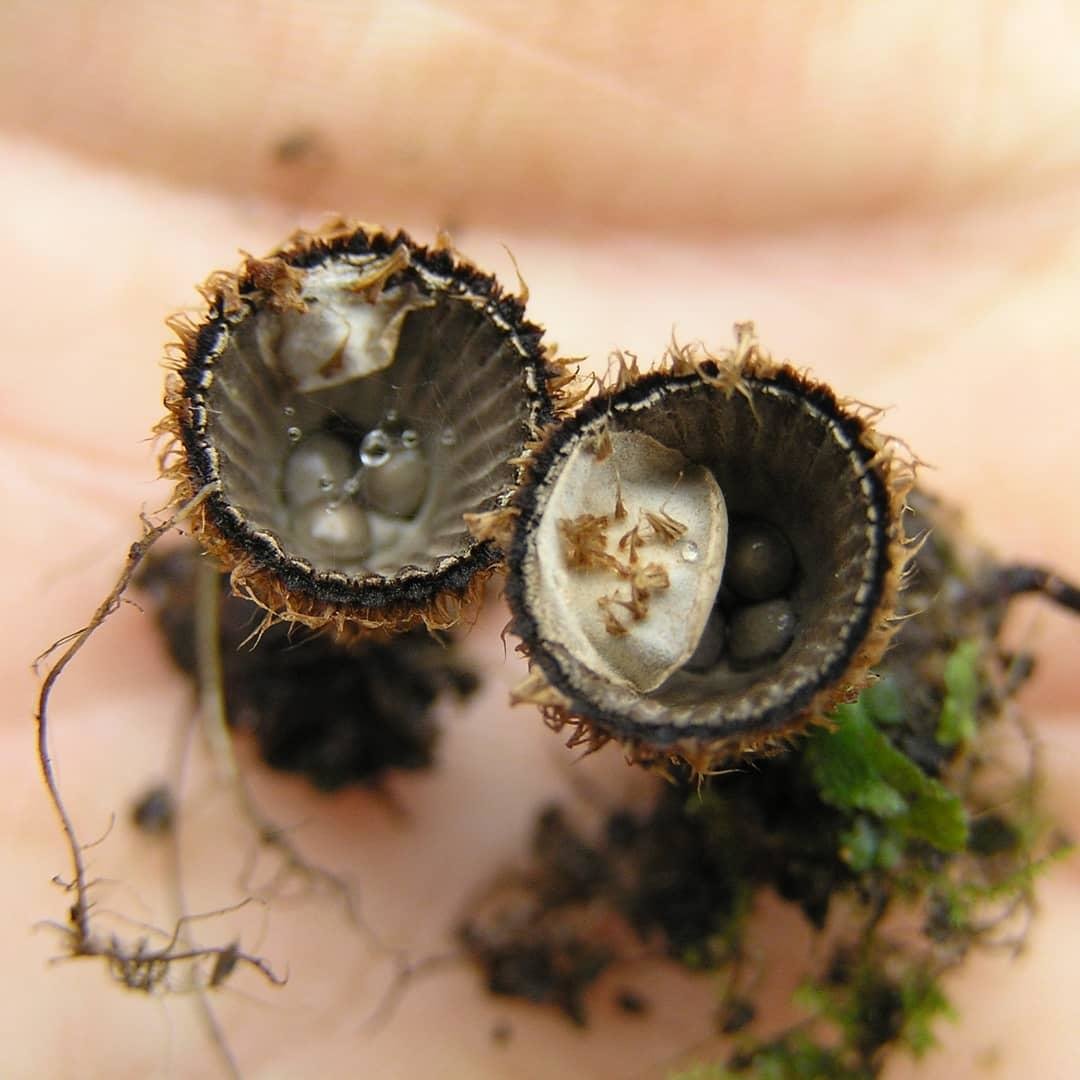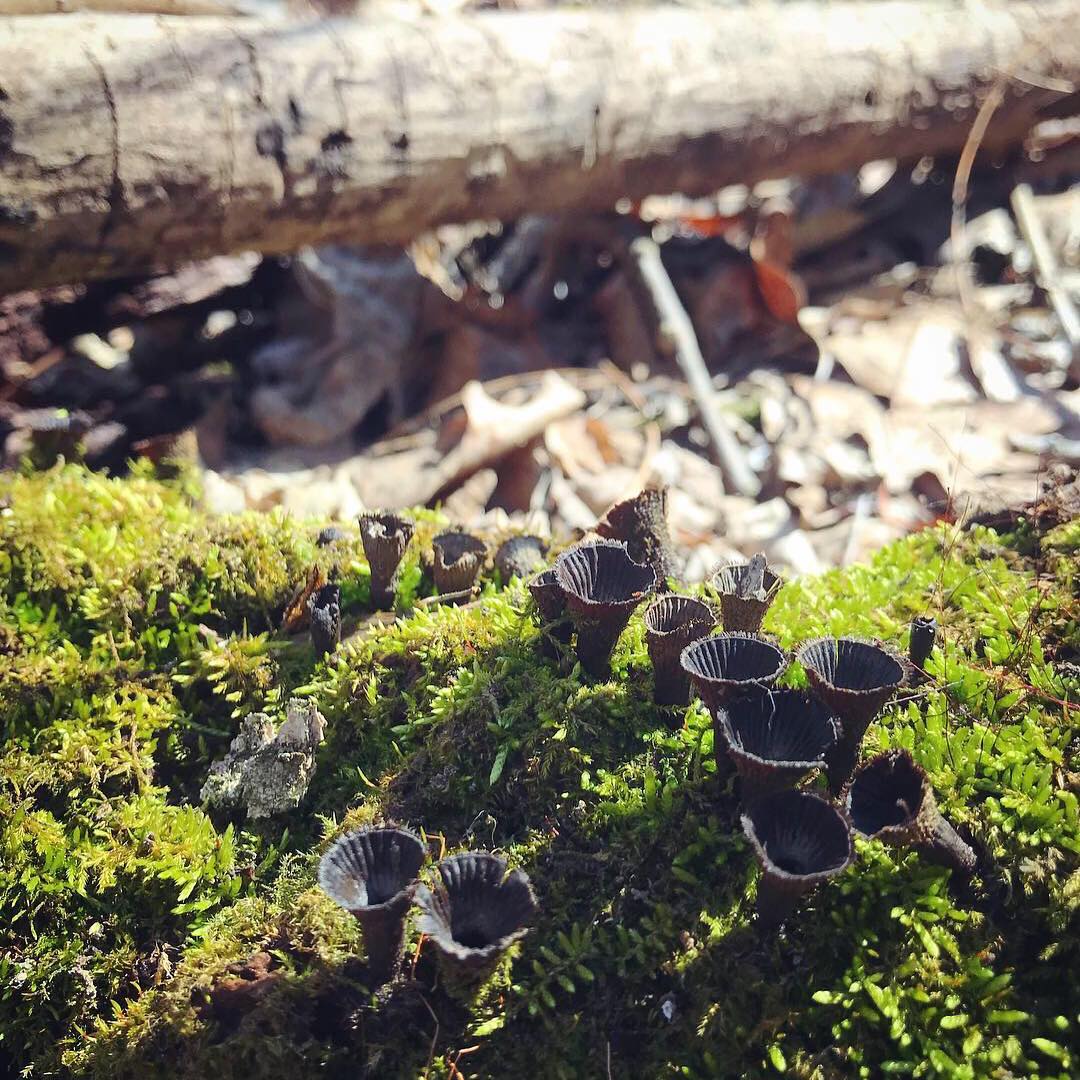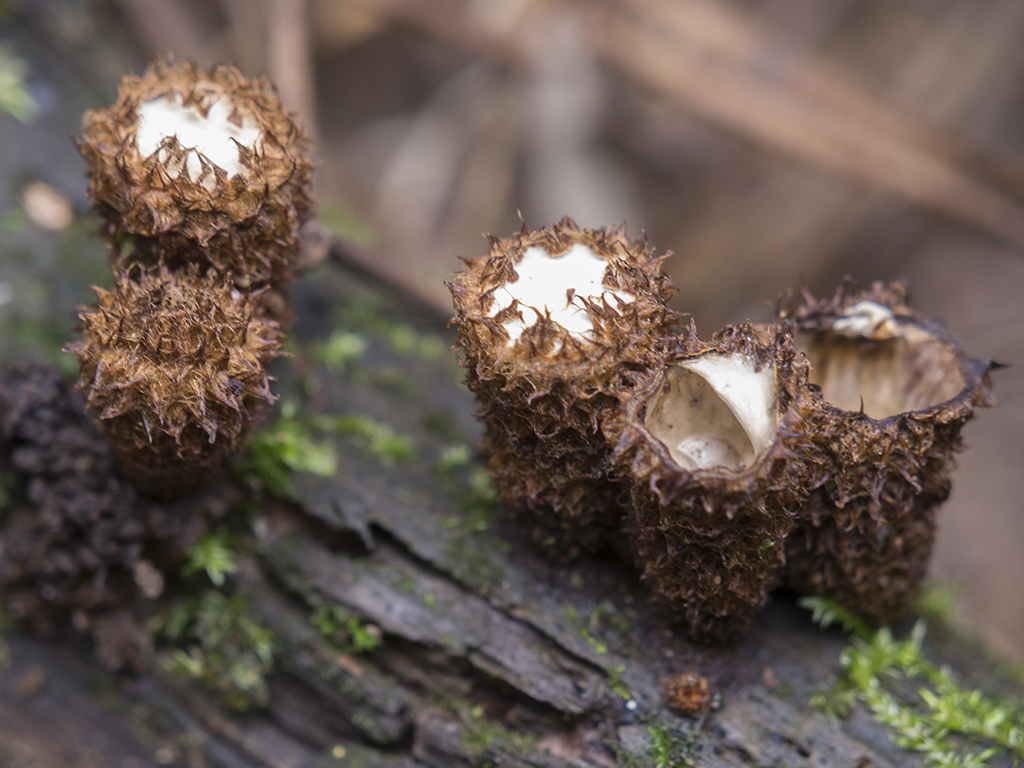Striped glass
Family: Nesting (Nidulariaceae).
Interesting information. The striped goblet (C. Striatus) is called by the British "a corrugated bird's nest", because it looks a lot like a miniature bird's nest with tiny testicles-peridiols (peridioli are leathery, flattened sacs with spores). Another European name for the striped glass - "splashing cups" - is associated with the way the spores spread: the sides of the fruiting body are tilted inward, which allows falling raindrops to knock out the peridioli with spores from the fruiting body and spray them around.
Description and photo. The striped glass has fruiting bodies 1-2 cm high and about 1 cm in diameter, at first ovoid, rounded, closed, fleecy, brownish-brownish, then become goblet, covered with a whitish felt film. When ripe, the film breaks (remaining partially on the inner walls), and the mushroom becomes goblet. The outer surface of the "goblet" is fleecy, reddish or brownish brown, the inner surface is longitudinally grooved, shiny, grayish, with brownish or grayish, shiny flattened small peridiols (2-3 mm in diameter) lying on the bottom, which fade in dry weather. The striped glass grows in moist deciduous and mixed forests and parks, on rotten branches, deadwood, deciduous stumps, on forest litter, on humus soil, near roads, as a rule, in dense groups, it is not often found throughout the temperate forest zone of Russia. Sometimes a striped glass is found on wood debris, at sawmills and even on rotting wood of various origins (straw
materials mulching sawdust, etc.) within the city. Fruiting from July to October.
Similar species. It is similar to other species of the genus Bokalchik, from which we can clearly distinguish it by the striped inner surface of the fruit chalk.
Pharmacological and medical properties. C. striatus is extremely rich in bioactive components. Back in 1971, it was proved that the fungus produces certain "indole" substances (multicomponent bioorganic molecules with an indole ring), as well as a complex of diterpenoid antibiotics. Together, these complexes are called cyatin. Several years later, studies have shown that indole substances are so-called striatins. Striatins (A, B and C) have a pronounced antifungal activity, and also inhibit gram-positive and gram-negative bacteria. The striped glass also produces sesquiterpenes, called schizandronols. In addition, it contains the triterpenoids glochidon, glochidonol, glochidiol and glochidiol diacetate, cyatinic acid, striatic acid, cyatadonic and epistriatic acids. The last four of the listed components were unknown prior to their isolation from C. striatus.
The mycelium extract and culture fluid of C. striatus showed antibacterial activity against Bacillus cereus and B. subtilis. After isolation of pure striatins (striatins A, B and C), the latter showed antibacterial activity against a large number of species of gram-positive and gram-negative bacteria, as well as activity against imperfect fungi. After the development of a method for the production of striatins by fermentation, these antibiotics were clinically tested against Leishmania amazonensis and Trypanosoma cruzi. These protozoa cause high mortality in tropical regions. Striatin A showed the greatest activity against Leishmania amazonensis after three days of treatment.
NF-kB (nuclear transcription factor "kappabi") is a protein complex involved in the regulation of the immune response to infections. Changes in NF-kB response are implicated in a variety of pathologies, including cancer.For example, it is known that in several types of human cancer, gene NF-kB regulation is usually turned on, disrupting normal gene expression and allowing some cells to survive in such conditions when other cells die. Mushroom extracts prepared from C. striatus show a significant inhibitory effect on NF-kB activation, which provides a good basis for further research in cancer therapy.
Not used in traditional medicine. Currently not going to. Not used for culinary purposes.
White mushroom (boletus)
There is a special category of mushroom pickers who disdain all mushrooms, except for white ones. "Well, just an empty forest, I found only a dozen mushrooms!" - in their mouths, this does not mean at all that the forest is really "empty": just for the sake of everything else, they will not bend over. You can do whatever you want with white: dry, pickle, salt, fry - and fry without prior boiling. As a rule, they prefer to dry it - in order to eat mushroom soup in winter.
White mushroom (Boletus edulis). Michael wood
A small boletus can be completely white, with age, its cap becomes brown, and then dark brown. Also, with age, the hat unfolds: in babies it is semicircular, with edges adjacent to the leg, in adult whites it is expanded, simply convex, maybe flat. The tubes (those that are on the inside of the cap) are first white, then light yellow, then greenish, even completely green. The boletus leg looks like a keg, widened downwards, white or creamy.
White mushroom (Boletus edulis). Dezidor
The porcini mushroom also has other forms: reticulated (with a slightly cracked cap), dark bronze (with a dark brown, almost black cap), rooted (yellow-brown in color, with completely yellow tubes and a leg and a slightly blue pulp on the cut) ... There is a royal boletus with a red cap and yellow tubes and a leg. They are all edible and delicious.
Carefully! White can be confused with the inedible gall and satanic mushrooms, as well as the poisonous rose-golden boletus. Gall mushroom
Ak ccm Satanic mushroom. H. Krisp Boletus pink-skinned, or rose gold. Archenzo
Gall mushroom. Ak ccm Satanic mushroom. H. Krisp Boletus pink-skinned, or rose-golden. Archenzo
- Gall mushroom, gall mushroom (Tylopilus felleus). An adult bile fungus has pinkish tubules and pores. It is not poisonous, but it tastes so disgusting that it is not for nothing that they called it bilious.
- Satanic mushroom, satanic sick (Boletus satanas). The Satanic mushroom is distinguished by a red leg (it is yellowish right under the cap) and orange-red tubes, the pores of which turn blue when pressed.
- Pink-skinned boletus, pink-skinned boletus, pink-golden boletus (Boletus rhodoxanthus). Pink-golden, poisonous, boletus is similar to a satanic mushroom: it has red tubes, also blue when pressed, and the leg is yellow, but with such a dense red mesh that sometimes it seems completely red.
The most unusual mushrooms in the world
Even the most avid mushroom pickers can surprise some mushrooms with their unusual appearance. Let's take a look at the most amazing mushrooms in the world.
At the top of this list is the luminescent mushroom (Chlorophos mycena). It would seem that neon mushrooms can only be in science fiction films, but they do exist. Mushrooms with unusual shine are native to Brazil and Japan. In these countries, unusual green mushrooms appear during the rainy season.
The edibility of luminescent mushrooms is unknown, this is due to the fact that few people dare to taste the luminous dish. They grow at the base of tree trunks, next to broken branches, on foliage and simply on damp soil. At night, you can enjoy the most beautiful lighting created by nature itself.
Bioluminescence is the incredible ability of living organisms to emit radiance. This phenomenon is associated with the chemical processes of the body and the release of energy released in the form of light. The ability to shine is observed not only in mushrooms, but also, for example, in fireflies and some types of jellyfish.
Unusual blue mushroom
Another unusual representative of the mushroom kingdom is the blue mushroom (Entoloma hochstetteri). These mushrooms are common in New Zealand and India. Its color is azure, but the spores are reddish. The color of the fungus is given by the pigment azulin, which is also found in some marine invertebrates. Although they are very beautiful mushrooms, you should not try them, they are not edible, however, their toxicity is poorly understood.
The Hydnellum Peck mushroom, which is also called a bleeding tooth, and its Latin name is Hydnellum peckii, looks very unusual. It is unlikely that anyone will want to taste this strange mass.
And it's worth noting that the taste of the pulp is incredibly bitter. Hydnellum Peka is more common than blue and luminous mushrooms. They grow in North America, Europe, Korea and Iran. They settle in coniferous forests, and bear fruit in the fall.
Another amazing mushroom is Nidulariaceae. Bird nest mushrooms grow in New Zealand. The mushroom has an original shape, which is why it got its name. This form of fruiting bodies serves for the spread of spores.
In spore eggs, rainwater accumulates, when they are completely filled, they burst, and the spores fly up to a distance of 1 meter.
The official name of this mushroom is Chorioactis geaster. The devil's cigar is considered one of the rarest mushrooms on earth. Due to the fact that this mushroom is found in Texas, it is also called the Star of Texas. However, the devil's cigars grow in two other areas of Japan.
While the spores of the fungus are inside the fruiting body, it looks like a brown capsule, which really looks like a cigar. When the mushroom opens up and releases the spores, it resembles a star or a cactus flower.
The devil's cigar, when throwing out spores, emits a whistling sound, it is the only mushroom in the world that can "talk". Maybe because of this, he got such an ominous name.
The name of this mushroom is unattractive; in addition, it has a rather indecent appearance. The Latin name for the mushroom is Mutinus caninus, which means "like a dog."
A mushroom with such an unattractive name is edible, but only at a young age, while it is in an ovoid shell and has a less defiant appearance. These mushrooms are listed in the Red Book. They bear fruit from July to October.
Canine mutinuses grow in the Stavropol Territory, Tomsk and Leningrad Regions, Krasnodar and Primorsky Territories, Karelia, Georgia, Armenia, Lithuania, Estonia and North America. These mushrooms settle on sawdust, rotten wood and stumps.
This mushroom is native to Australia. The scientific name of the mushroom is Aseroe rubra. This unusual mushroom belongs to those species that do not look like mushrooms at all. It looks more like some kind of outlandish tropical flower, for example, a staple or rafflesia. In addition to the fact that the sea mushroom looks similar to these flowers, it also uses the services of flies. Flies carry fungal spores. The sea mushroom, rafflesia, and stapelia all give off an unpleasant smell of musty meat that flies like very much.
Anturus archeri (lat.Clathrus archeri) - devil's fingers, octopus or starfish?
When the anthurus archer mushroom opens, it looks like a starfish or octopus. Usually has 4 to 7 pinkish-red "tentacles". Popularly known as the devil's fingers, the world's creepiest mushroom. It is easy to recognize not only by its appearance, but also by the terrible unpleasant smell of the falling. The scent attracts flies, which spread spores. Anturus archer grows in groups, often among wood chips, old stumps and fallen leaves. It originally grew in Australia and Tasmania, but now it can be found in Europe and North America and Asia. Do not taste this mushroom when opened, it is inedible.
Unopened mushroom Anturus archer.
Where and when do milky mushrooms grow?
Mushrooms of the milky genus grow all over the world, meeting on the following continents: Eurasia, Africa, Australia, North America, South America. But they are especially abundant in the temperate zone of the Northern Hemisphere. Here the lactariuses form fruiting bodies in the summer in June-July.If the summer is dry, then "fruiting" is postponed to August-September. Since most of the species are cold-resistant and moisture-loving, they can bear fruit especially abundantly in autumn. But the lactarii do not grow for long, forming only 2 layers of fruit chalk.
If there are prolonged rains in the spring, then the milkmen will be very rare, since they do not like excessive moisture.
Mushrooms of this genus live in symbiosis with many species of deciduous (usually birch) and coniferous trees. Brown milky (Lactarius lignyotus) forms mycorrhiza with spruce, white milky (Lactarius musteus) - with pine, brown milky (Lactarius fuliginosus) - with oak and beech, pale milky (Lactarius vietus) - with birch.
Mushrooms grow, as a rule, in damp places of the forest or on its edges, but they are also found in parks, in meadows, where there are tree roots. They often settle in the soil, sometimes on rotten wood or moss. The temperature favorable for their development ranges from 10-20 ° С. Fruit bodies live for 10-15 days, after which they rot. More often, milkmen grow in groups, some of them can form "witch's rings", for example, mushrooms and milk mushrooms.
The miller is gray-pink. Photo by: Björn S…, CC BY-SA 2.0

